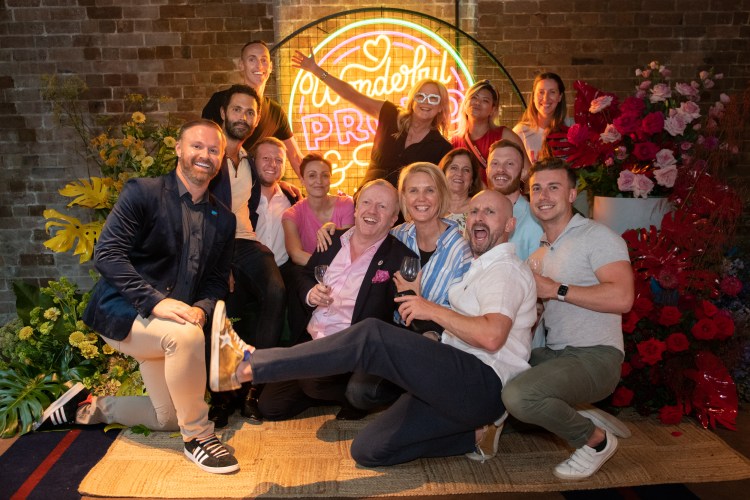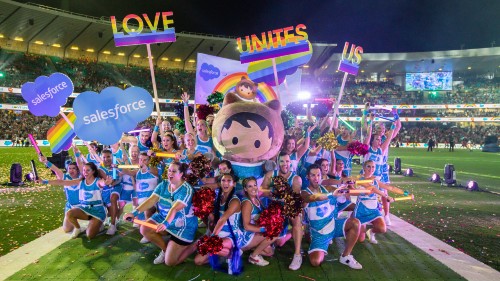How Businesses Can Enact Meaningful Change for Transgender Employees



For Transgender Awareness Week we’ve launched our Gender Inclusive Benefits. Discover how your business can take real-world action in the name of equality.
Salesforce Staff
To coincide with Transgender Awareness Week (13-19 November), Salesforce is proudly launching a new suite of Gender Inclusive Benefits that include Australian and New Zealand employees. These benefits offer financial and leave support for employees on their gender affirmation journey.
If anyone knows how life changing such benefits can be, it’s Salesforce New Zealand’s Manu Erwin (she/they). We sat down with Manu to hear her story and discover how businesses can take real-world action in the name of genuine equality, diversity, and inclusion.
Earlier in 2021, Manu Erwin, Principal Solution Engineer at Salesforce, took to LinkedIn and made an announcement:
“I am happy to share that I am trans, my gender-identity is femme, my pronouns are she/her/hers and I’m keeping my name Manu.”
This announcement was a significant step in what Manu calls “a series of journeys”. She’d always considered transgender as something for other people, and therefore hadn’t researched it too deeply. But then after an online journey took her from browsing shoes to reading up on the concept, she made a realisation.
For the very first time in her life, she had discovered the language that allowed her to articulate what she had been feeling for so long.
At the beginning of her journey, Manu was convinced she fit into the societal definition of a woman and would never be anything else. Now, Manu no longer feels the need to conform to any one binary identity. She is trans-femme non-binary and understanding what that means for her is a process of becoming who she’s always been and will be.
A life-changing series of events
For Manu, that process of ‘becoming’ has included a progression towards physical transformation — a progression that isn’t well supported by either the government or medical and insurance companies in New Zealand. After discovering the public system wait was 10 years at least, she met with a private surgeon to discuss her options.
A meeting and a ballpark figure later and Manu had set a new savings goal — one that she would have to put everything towards for a number of years. That is, until a life-changing moment a few weeks later, when Karen Hendrickx (she/her), Director, Regional Success Architect at Salesforce, informed Manu of the development of the Gender Inclusive Benefits.
“I’ve known firsthand of the amazing work that we do, especially when it comes to equality. And then, for this to come along… well… It is truly walking the talk!”
In this case, walking the talk includes financial (medical, legal, and wardrobe) and leave benefits for Salesforce employees undergoing gender affirmation surgery, as well as emotional support including counselling.
For Manu, the benefits represent the “future of goodness in the world” and are an example of real, meaningful diversity and inclusion.
Words for other businesses looking to support transgender employees
A study in Australia found that 30% of the trans and gender diverse respondents had suffered discrimination in the workplace, and a study in New Zealand revealed that trans and gender diverse people suffer from high or very high psychological distress at rates nine times higher than the general population.
The numbers are sobering, but according to Karen and Kathleen Francis (she/her), Senior Director, Employee Success Business Partner, who are part of the team leading the Gender Inclusive Benefits rollout in Salesforce ANZ, there are steps businesses can take to ensure the transgender community feels seen, heard, valued, and empowered to be their authentic selves.
1. Start with understanding the trans experience
“If you’re looking to take the first step in creating benefits that support the transgender community, it all begins with education and listening,” says Kathleen, whose exposure to the trans and gender diverse community was previously limited.
When the Salesforce ANZ team initially started developing the benefits, there were no openly transgender employees with whom to consult, but Karen, however, served as producer at JOY radio and had decades of experience with the transgender community both in front of and away from the microphone. Karen’s personal connections meant she was able to identify the types of benefits that would make a difference in a trans or gender diverse person’s life.
While not all companies have relationships with the trans community there are organisations, such as Pride and Diversity, that companies can call upon to understand the trans experience.
“These organisations are an incredible resource and support to businesses” explains Karen. “As advocates they can review the language used in your benefits and make recommendations on how to develop benefits that are inclusive.”
As part of their research, the Salesforce team connected with Pride in Diversity to investigate examples of other programs and to determine the specifics of what they should offer transgender people. What stood out to Karen and Kathleen when reviewing the benefit examples was the absence of financial support.
“We were always aspiring to include a monetary benefit,” explains Kathleen. “But seeing the consistent inclusion of unpaid leave and employee support materials [without financial support] in other policies, meant we could be a market leader for trans and gender diverse benefits and a vocal advocate for the trans community.”
2. Create safe online and physical spaces
Creating a culture that celebrates who trans and gender diverse people are and puts their physical, mental, and emotional wellbeing first, is just as important as a benefits program.
As Kathleen explains “it’s about creating that safe space within your organisation for the transgender community to communicate, and for employees to educate themselves on transgender issues.”
Equality has long been at the heart of Salesforce, and so too have the Salesforce Equality Groups. For Manu, she has been welcomed with “rainbow arms” into Outforce and the Women’s Network, and the many private and public Slack channels around trans and transgender acceptance.
“It really is empowering to have these channels where you can feel safe to share what you are experiencing and know you’re going to be supported,” says Manu.
And that support is coming from top down. Salesforce’s ANZ CEO Pip Marlow (she/her), who Manu describes as one of “Manu’s amazing, beautiful, humans” has started introducing herself at the ANZ company All Hands with her pronouns. Being able to voluntarily self-identify, including sexual orientation, gender identity, and pronouns, across events and workplace systems, is one part of Salesforce’s commitment to creating a more inclusive workplace environment.
3. Benefits must be accessible and diverse
It’s important that if offering any extent of benefits that the path to claiming them is unobstructed. Anything that might be a barrier to someone feeling comfortable enough to take the journey — such as having to explain why they need to take leave — should never be a part of the process.
As Karen stipulates, “allow employees to be anonymous. They shouldn’t have to out themselves to access any type of benefit.”
Ultimately, all benefits should be as diverse as the employees they serve. For trans and gender diverse benefits, that means including benefits for all aspects — social, legal, and medical — of the gender affirmation journey.
As Manu said, these benefits represent real inclusion. Employees no longer want perks – they want action and a culture that represents their values and celebrates diversity.
“What do you think the cost of not doing at least the bare minimum — such as offering unlimited unpaid leave for those seeking transformation — will be?” asks Karen.
The cost is losing the value people with diverse experiences can contribute to a workplace and progress towards greater equality for all.
Read more about Salesforce’s commitment to equality.
Read more about Salesforce’s
commitment to equality






















